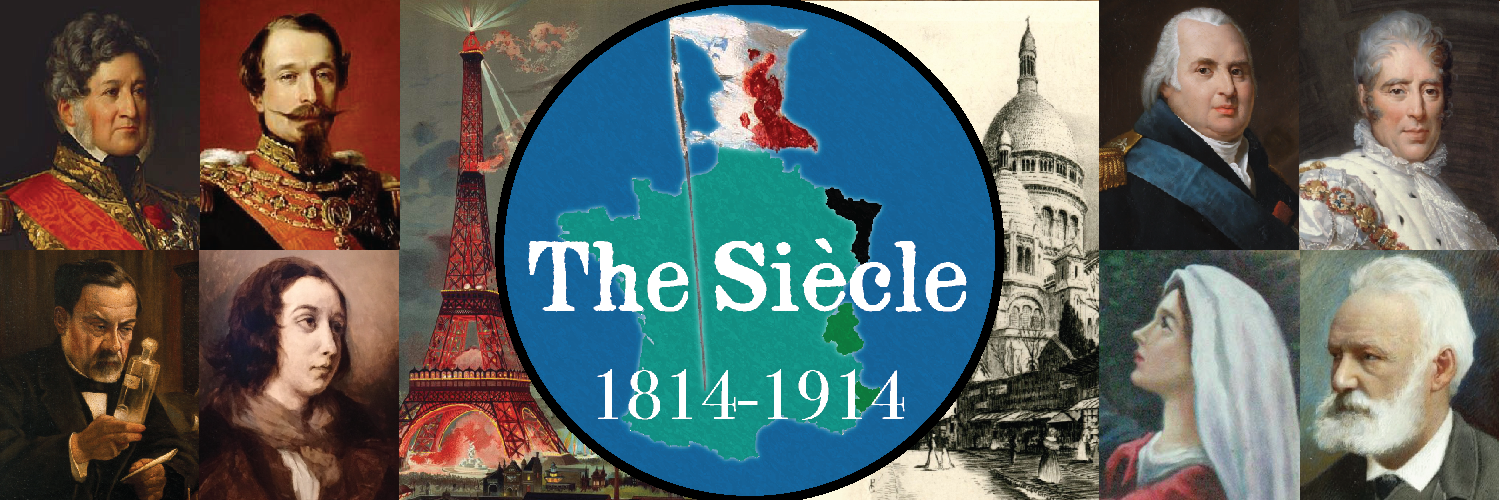Supplemental 16: Restoration Elections
This is The Siècle, Supplemental 16: Restoration Elections.
Welcome back, everyone.
I’ve talked quite a bit about elections on this podcast, but usually I’ve focused on three elements: who was eligible to vote, how candidates campaigned, and who won. Today I’d like to get a little bit more granular and lay out for you exactly how elections were organized during the Bourbon Restoration.
This isn’t the sexiest topic, I know. Some of you are probably already reaching for the skip button. But I think the nitty-gritty details here are both important and interesting. Restoration France had elections, but they were radically different from the elections we know today — and not only because only rich men were allowed to vote. Understanding how this all worked, and how it breaks from our assumptions, will provide a crucial foundation to understand all this political drama. I know I found merely writing this to be incredibly helpful.
All set? Okay.
An ever-changing system
Restoration France had a single elective body of note: the national Chamber of Deputies. This was the lower house of France’s parliament, paired with an appointed Chamber of Peers. The deputies were elected based on a limited, wealth-based electoral franchise — only male citizens who were at least 30 years old1 and paid at least 300 francs per year in direct taxes were allowed to vote. Essentially, this limited the vote to the richest 1 percent or so of French men. To actually serve in the Chamber, the bar was higher still: you had to be 40 years old and pay at least 1,000 francs per year in taxes. I talked more about the reasoning behind this limitation back in Episode 7.
The Chamber of Deputies itself was composed of several hundred different deputies; the exact number was adjusted up and down over the years, but the general principle was that deputies were assigned to each department on the basis of population, more or less.2
For example, the Seine Department, home to Paris, had eight regular deputies in the 1820s, to go with around 822,000 residents in 1821. Lyon’s Rhône Department had 3 regular deputies and just under 400,000 people. Tiny Vaucluse had just two deputies for 224,000 people. If you’re doing the math in your head, that’s on average around one regular deputy per 110,000 people, give or take. And that includes all residents, not merely the handful of wealthy adult men who were allowed to vote.3
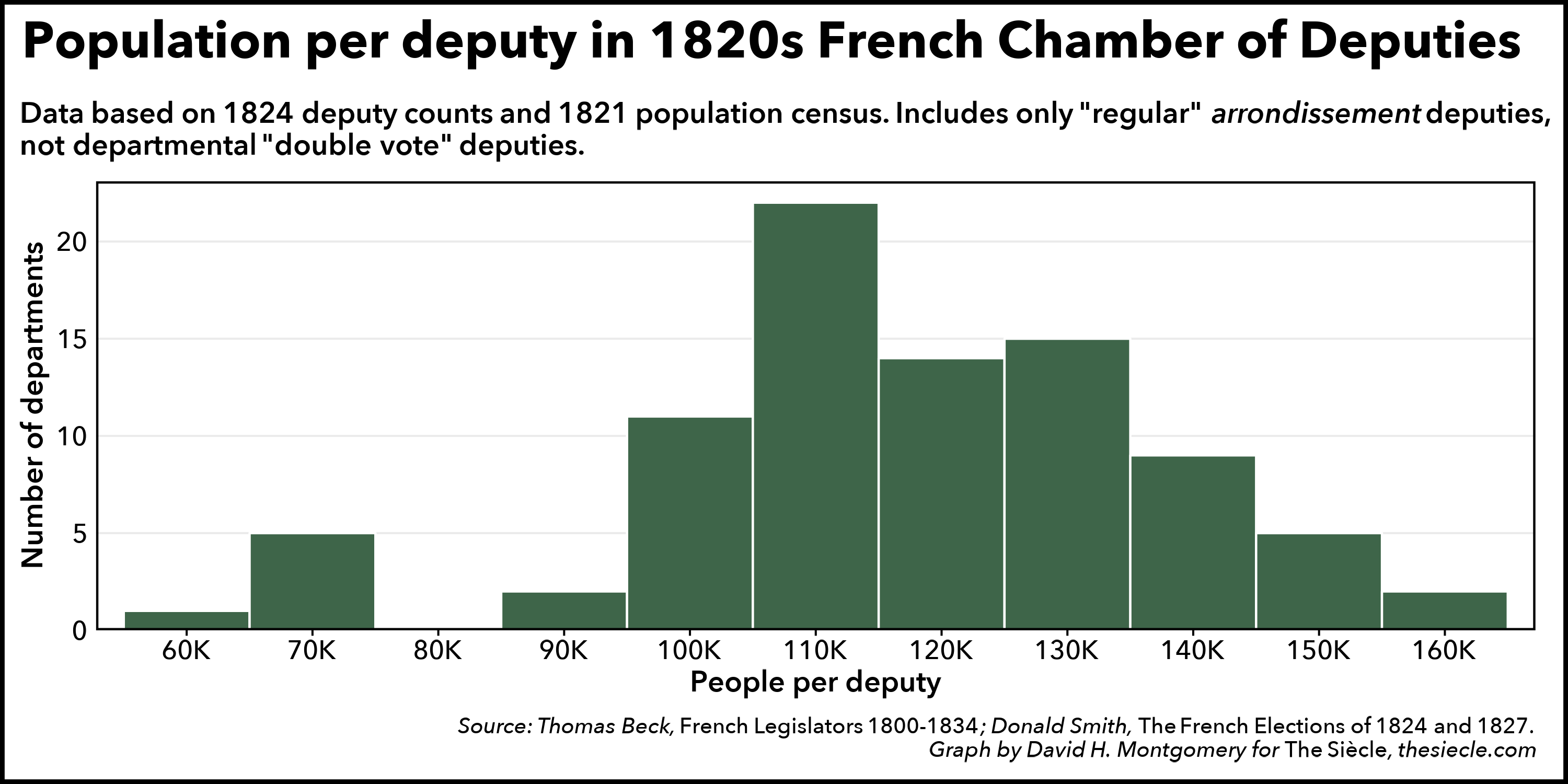
The precise details of how each department’s deputies would be elected was changed several times over the course of the Restoration. In general, the small electorate would meet in local or regional “electoral colleges” to make their decisions. But successive governments kept making big changes, as both liberals and royalists tried to write electoral laws to produce friendly chambers.4
In 1815, there was a two-stage system: electors would meet in their local communities to nominate candidates, while a second electoral college for the entire department would then choose the actual deputies. Interestingly, the departmental colleges weren’t limited to the local college’s nominees — they could pick their own candidates, too, as long as half of their chosen deputies came from the local nominees.5
A new law passed by a more liberal government in 1817 changed things up. The local colleges were abolished, with departmental colleges both nominating and directly choosing all their assigned deputies. In 1820, a royalist government brought the local colleges back, but now each one directly elected a single deputy. That same law kept departmental colleges around, and gave them a separate group of 172 deputies to elect — but infamously restricted the departmental colleges to just the richest 25 percent of electors in the so-called “Law of the Double Vote.”6
In this confusing tug of war we saw the local colleges go from merely suggesting candidates to being abolished to directly electing deputies. Departmental colleges chose all the electors in the 1815 and 1817 laws, while in the 1820s they were reserved for the wealthy double-voters. This makes it annoyingly hard to compare one election to another, though thankfully the major French elections in 1820, 1824, 1827 and 1830 were all conducted under the same laws.
Exceptions
Complicating all this further is that some of the really small departments were exceptions to the law. The island of Corsica and a half-dozen departments in the Alps, the Pyrenées and the Massif Central mountain ranges7 didn’t follow the “double-vote” system set up in 1820. Instead of local colleges each electing a single deputy, and the wealthiest voters picking another set at the departmental college, these rural areas had a single departmental college at which all electors — not just the “double-voters” — picked the department’s entire slate. Even with this special setup, voter turnout could be shockingly low; at one extreme, Corsica had just 50 eligible voters for the entire island. France’s 1814 constitution, the Charter, even made an exception to the wealth requirements for these small departments — if they couldn’t find 50 eligible candidates, then the next-most-wealthy men would gain eligibility.8
There was also an interesting exception to the law restricting the vote to male citizens paying at least 300 francs per year in direct taxes. While neither unmarried women nor married women had political rights in the Restoration, widows did — sort of. Rich widows had the legal right to vote, but couldn’t exercise it themselves. What they could do is designate a male relative to vote on their behalf, even if he himself didn’t qualify as a voter. As if this weren’t complicated enough, this right sometimes ended up in court over which relatives widows could delegate their vote to. For example, grandsons took precedence in the law over sons-in-law. But if a widow had an underage grandson who couldn’t vote, was she allowed to skip him and give the vote to her son-in-law who could? One prefect said no, but the widow sued and won.9
Patente-ly absurd
Even for men over 30, proving that they had paid at least 300 francs in direct taxes wasn’t always easy. Historian Sherman Kent notes the “stacks of documents” in the French archives trying to sort out complicated questions like “direct taxes paid by multiple-ownership businesses,” living trusts, and property owned in multiple departments. A would-be voter had to have owned property for at least a year for it to qualify, so sometimes the precise date of sale made the difference.10 That wasn’t even counting deliberate fraud and trickery men would use to get the right to vote. Sometimes rich patrons would give property to a brilliant but insufficiently wealthy ally in order to get him over the threshold. Even sneakier were candidates who would make “a fictitious purchase of taxable property” that they could show a prefect as proof, while also drawing up “a secret counter-deed that would nullify the sale.”11
Let’s back up for a moment. I’ve been talking about voters getting eligible by paying 300 francs in direct taxes. You might be wondering what exactly constitutes a “direct tax.” The short answer is any tax that you pay directly to the government, as opposed to an indirect tax like sales tax paid on a purchase. But the long answer is that under the Restoration, there were four taxes that were looked at to determine voter eligibility:
- First, the contribution foncière, or a tax on real estate. This was “the most important of the direct taxes” and brought in as much as two-thirds of all direct tax revenue. The contribution foncière primarily taxed land rather than buildings, but that’s mostly because other taxes came for the buildings.12
- Second was the contribution personnelle et mobilière, which was actually two taxes that were always treated as a pair. The personnelle was a poll tax, a relatively small per-person fee; the mobilière tax was a much more significant levy on the rental value of homes.13
- Third was the contribution des portes et fenêtres, or the door-and-window tax. This was exactly what it sounds like: a property tax based on the most easily observable part of a home: the number of doors and windows it had. Poorer French families responded to the existence of this tax by building homes with as few openings as possible, resulting in many very dark houses.14
- Fourth and finally was the impôt des patentes, a business license tax. Just about every type of profession required a license, which had a fee, and that fee counted toward the 300-franc voting theshold. Depending on your job and how big a town you lived in, your patente could be as low as 3 francs or as high as 300.15 While old landed aristocrats might get their electoral eligibility from the contribution foncière on their vast tracts of land, the patente was the primary way for the bourgeoisie to earn the vote.16 It also served as a workaround: if you had money but didn’t pay enough taxes to vote, you could just find a professional license that cost enough to put you over the top. We have records, for example, of a prominent retired general who took out a surveyor’s license.17
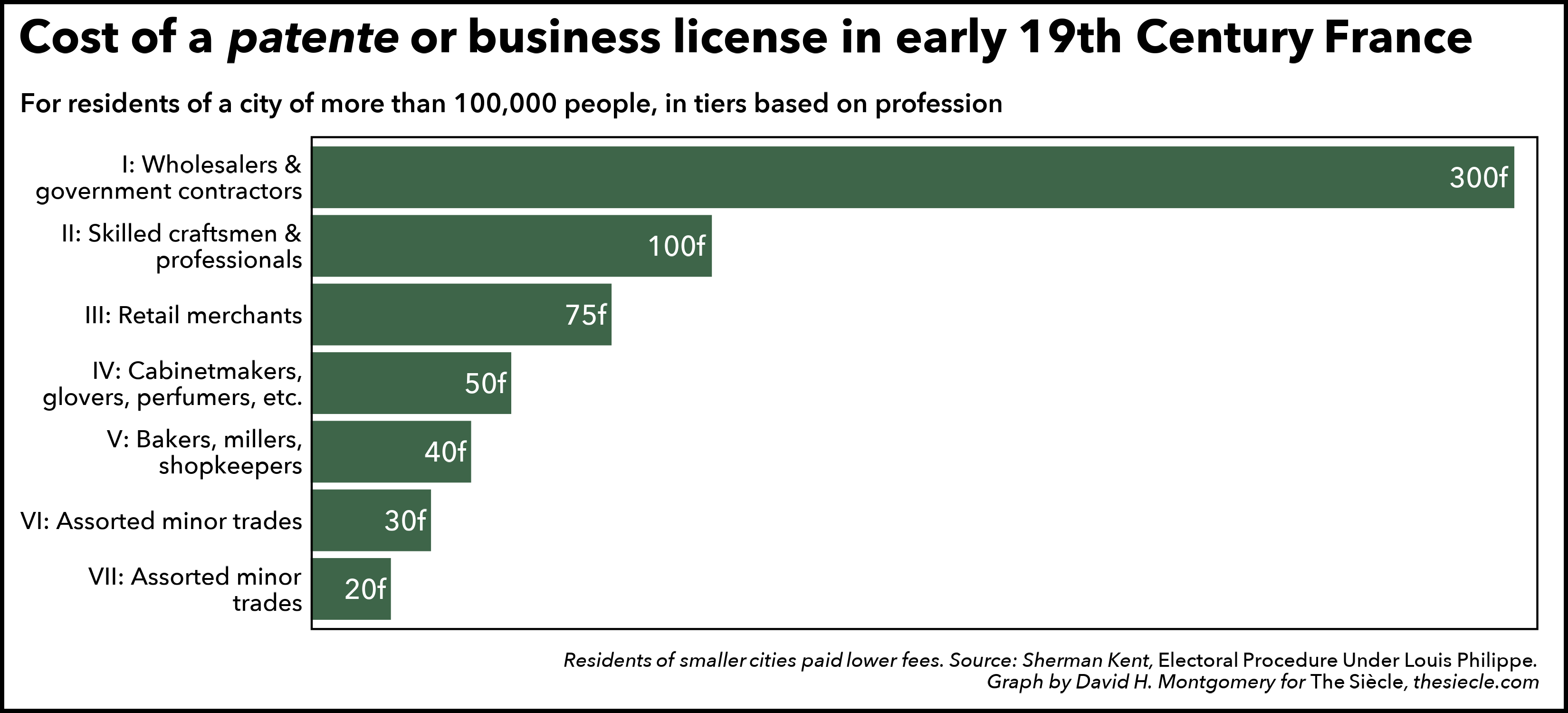
Some combination of what you paid in those four taxes had to exceed 300 francs in order to get you a ballot, while 1,000 francs was needed to become a candidate. And if that breakdown was a little too into the weeds for you, let me just assure you: the level of detail I just provided is foreshadowing on my part. This is going to come up again in our narrative.
There were, of course, also political factors behind registering to vote. In Episode 31 I talked a lot about how prefects would try to manipulate the voter rolls to leave off known opposition voters and sign up loyalists. Some of this skullduggery was curtailed by an 1827 law that formalized the voter registration process with an annual registration period and an appeals process through the courts. Both of these made it easier for opposition voters to get registered.18
If you did make it through the red tape and got registered as a voter, you would receive an “electoral card” delivered to you, which told you where you needed to report at 8 a.m. on Election Day and served as a credential granting you access to the hall. Unless, of course, you were an opposition voter whose electoral card just happened to get lost in delivery, as sometimes happened.19
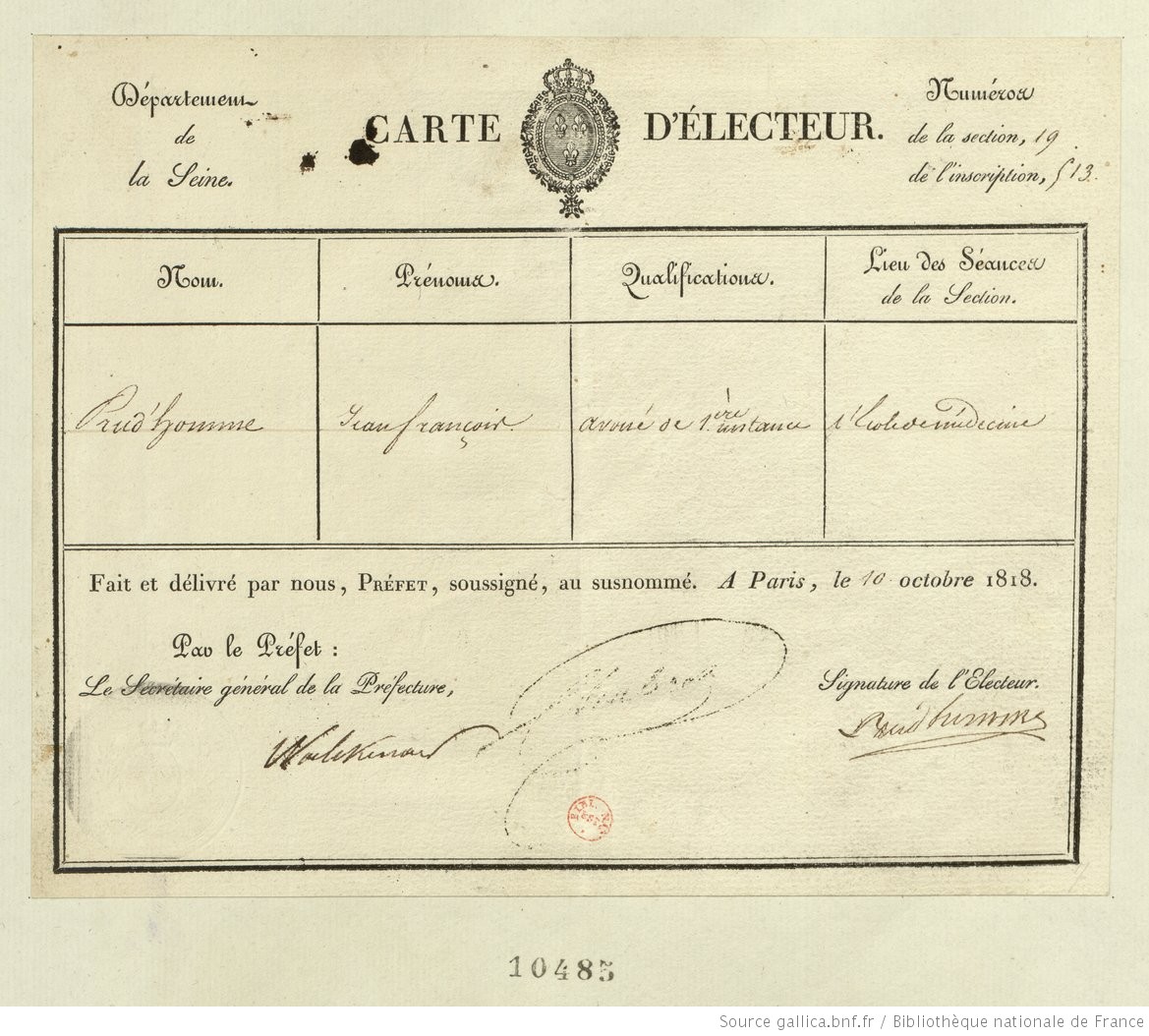
Above: An 1818 electoral card for one Jean-François Prud’homme in the Department of the Seine. Public domain via Bibliothèque nationale de France.
Going to (electoral) college
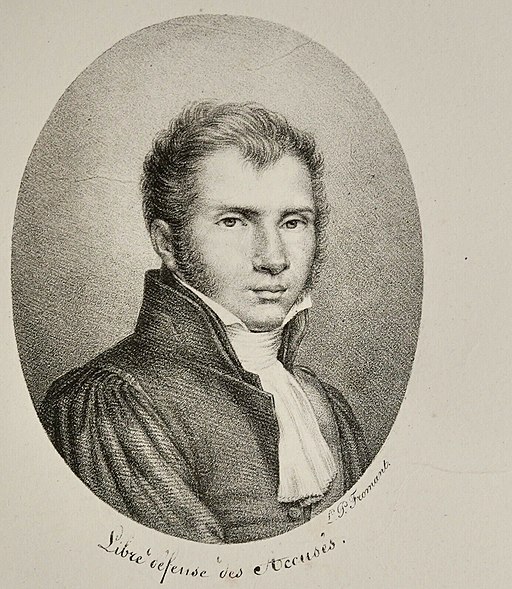 The first order of business for each electoral college was electing a “permanent bureau” — four ballot-counters and a secretary to oversee proceedings. A “provisional bureau” had already been chosen by the college’s president, a royal appointee, and electing the permanent bureau was a key political test. A pro-government college would ratify the appointment of the provisional bureau, but an opposition-leaning college might appoint their own staff. This mattered, because the bureau was in charge of settling vote disputes, which could make a big difference in closely contested colleges. For example, in one 1824 race, General Maximilien Foy got elected only because a friendly bureau counted handwritten votes for “Foy”, “General Foy” and “foy foy” as valid. A hostile bureau could have thrown these out as technically incorrect. This happened in a different department, where the liberal attorney André Dupin lost because the bureau disqualified votes cast for “Dupin the Elder” — the name he was frequently called to distinguish himself from his younger brother, the prominent mathematician Charles Dupin.20
The first order of business for each electoral college was electing a “permanent bureau” — four ballot-counters and a secretary to oversee proceedings. A “provisional bureau” had already been chosen by the college’s president, a royal appointee, and electing the permanent bureau was a key political test. A pro-government college would ratify the appointment of the provisional bureau, but an opposition-leaning college might appoint their own staff. This mattered, because the bureau was in charge of settling vote disputes, which could make a big difference in closely contested colleges. For example, in one 1824 race, General Maximilien Foy got elected only because a friendly bureau counted handwritten votes for “Foy”, “General Foy” and “foy foy” as valid. A hostile bureau could have thrown these out as technically incorrect. This happened in a different department, where the liberal attorney André Dupin lost because the bureau disqualified votes cast for “Dupin the Elder” — the name he was frequently called to distinguish himself from his younger brother, the prominent mathematician Charles Dupin.20
Above: André Dupin, a famous liberal lawyer and politician often called “Dupin aîné,” or “Dupin the Elder,” to distinguish him from his brother, the mathematician Charles Dupin, by L.P. Fromant, circa 1815. Public domain via Wikimedia Commons.21
Electing the permanent bureau took the entire first day of the college, along with formalities like swearing-in the voters. After the bureau was elected, the college would adjourn for the day. Some busy voters didn’t bother showing up until the second day, when deputies would start getting chosen, so a win or loss in the vote for the bureau didn’t necessarily guarantee which deputies would win.22
The actual voting took the form of writing candidates’ names on pieces of paper, as my examples just now suggested. This was completely free-form — there were no nominating speeches, or even nominations of any sort. If you were a voter, you could vote for whoever you wanted — but probably knew going in who the candidates for your political faction were.23 You can imagine how important organization and pre-vote strategy sessions were to success.
Another quirk of the Restoration elections was that it was considered unseemly for a candidate to openly campaign. France wasn’t unusual in this — this taboo was common in 19th Century American elections, too24 — but it led to a sort of absurd ritual where candidates would loudly insist they had no interest in the job while also making it clear they would serve if elected. As an 1824 pamphlet put it, “One may wish to be named, but pride and self-respect forbid that this be made known in public. Ask a man in public if at the bottom of his heart he desires… to become a member of the chamber…, he will answer you that he has never dreamed of such a thing.” André Dupin had more self-awareness than most when he insisted that the circulation of his name as a candidate was merely “the spontaneous action of his friends” but that “surely I would not press self-abnegation to the point of hurting my chances.”25
The ballot you submitted with the name of your chosen candidate was not likely to be private. Restoration France had a secret ballot, but it was optional. What this meant is that only opposition voters would usually bother to vote privately — making it quite obvious who wasn’t voting for the government candidate. One ultra-royalist college president bragged in 1824 how “all the voters cast open ballots in my presence… the most horrible liberals wrote their choice under my gaze in favor of the royalist candidates.”26
It’s worth noting that public ballots weren’t unique to the Bourbon Restoration’s semi-authoritarian system. Public ballots appeared even in freer places. Britain didn’t adopt a secret ballot until 1872, after more than a generation of debate.27 In the United States, the secret ballot was more common in the early republic, but Virginia and Kentucky had public ballots throughout the first half of the 19th Century, and other states like Connecticut and Illinois experimented with it.28
Graduating from (electoral) college
The process of actually determining a winner depended on the structure of your electoral college. Local electoral colleges under the 1820 law only elected a single candidate, who needed a simple majority to win. If no candidate had a majority on the first ballot, a second and third ballot could be held, with the third ballot being restricted to just the two leading candidates from the second ballot.29
Complicating things further was that electoral colleges only cast one ballot per day. Each round of voting ended with an adjournment for the day, which by law was supposed to happen by 3 p.m. So every subsequent round of voting required an extra day of attendance by voters, for whom attending the college might already involve a significant expense. 30
Things got more interesting at departmental colleges, which usually had to elect multiple deputies. Here voters got to cast as many votes as there were deputies to elect; an absolute majority of eligible voters was required to win.31
 For an example, we can look at the 1818 attempt of the Marquis de Lafayette to get elected to the Chamber of Deputies. Lafayette ran in his home department of Seine-et-Marne, and was fiercely opposed by the local prefect. On the first day of voting, one incumbent deputy had 598 votes out of 878 voters, well over 50 percent; he was elected right away. Over 60 individuals received at least one vote; Lafayette was fourth with 281 out of 878. On the second day, there were two seats remaining, so each voter cast two votes. Two ministerial candidates won majorities, and thus seats in the Chamber, while Lafayette remained well short. 32
For an example, we can look at the 1818 attempt of the Marquis de Lafayette to get elected to the Chamber of Deputies. Lafayette ran in his home department of Seine-et-Marne, and was fiercely opposed by the local prefect. On the first day of voting, one incumbent deputy had 598 votes out of 878 voters, well over 50 percent; he was elected right away. Over 60 individuals received at least one vote; Lafayette was fourth with 281 out of 878. On the second day, there were two seats remaining, so each voter cast two votes. Two ministerial candidates won majorities, and thus seats in the Chamber, while Lafayette remained well short. 32
Right: Gilbert du Motier, Marquis de Lafayette, by Louise-Adéone Drölling, 1830. Public domain via Wikimedia Commons.
But this was not the end for the old revolutionary. One important quirk in Restoration elections was that candidates could be elected in departments where they didn’t live, and they could be nominated in multiple departments at once. Figures of national renown like Lafayette often received votes in several different departments, where local organizers thought a celebrity candidate might have a better shot than some local bigwig.33
So even as Lafayette lost at home, he was being talked up by a liberal activist in the western department of the Sarthe — a remote region where the ministry had less influence. With four seats available in the Sarthe, three liberal candidates won outright majorities on the first day. Lafayette came in fourth, but with 48 percent was just shy of getting elected. The ultraroyalist incumbents all trailed.34
Trying to prevent Lafayette’s election, the prefect used his powers to adjourn the electoral college for two days — hoping that liberal voters would return home, giving Ultras a shot. But the liberals held firm and stuck around. When voting resumed with a single seat on the line, Lafayette was elected with 596 out of 1,055 votes.35
The prefect’s decision to arbitrarily adjourn the Sarthe college is an example of the government’s broad power to set and change the dates of elections as it wished. This included everything from the minor, like bureau presidents starting their sessions an hour late on Sundays so voters could attend mass,36 to much bolder delays. In 1827, the Nov. 6 announcement of elections on Nov. 17 didn’t give enough lead time for far-away Corsica to get things organized, so Corsican voters got a special election date of Jan 3.37 Most blatant were events like happened in 1818, when the government delayed six electoral colleges an extra week — apparently in an attempt to disrupt opposition candidates. In fact, this backfired — the moment Lafayette lost his first election in Seine-et-Marne, a messenger was on the way to the Sarthe, whose election had been delayed, letting voters there know that votes for Lafayette wouldn’t be wasted.38
You get a seat — but only one
In Restoration elections after 1820, the local colleges would meet first, followed a week later by the “double-vote” departmental colleges. This gave candidates who lost in the local round a chance to run again in the departmental college, and it wasn’t uncommon for these second-chancers to win.39
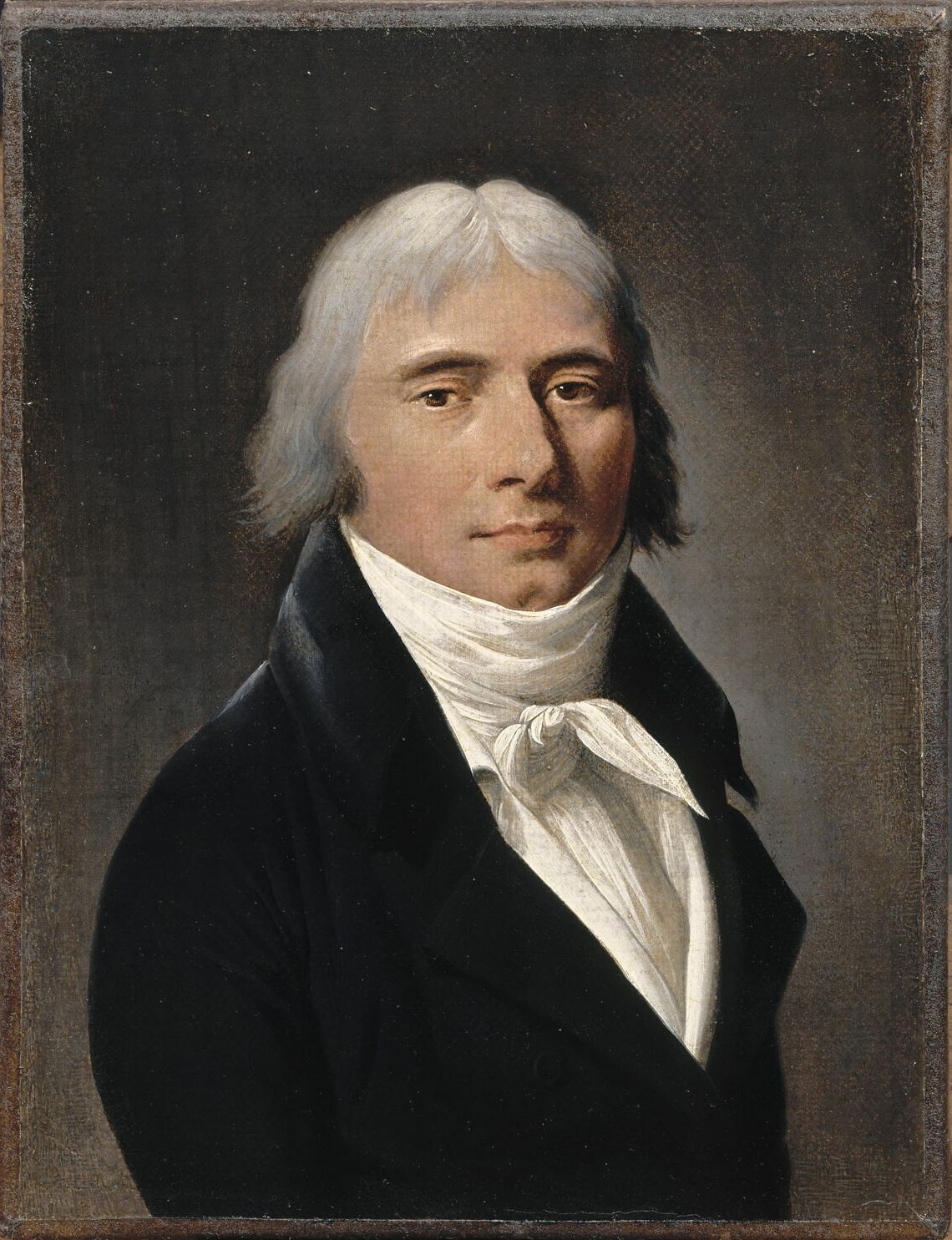 Even more interesting was what happened when a candidate managed to get elected in more than one district. These multiple winners then had to choose which seat they’d occupy, and resign the others. In one extreme example, the 1827 elections saw the Doctrinaire orator Pierre-Paul Royer-Collard run in 14 different elections and win in nine of them. Those vacancies would have to be filled by special elections in the weeks and months to follow, along with other vacancies that happened when winners died or resigned before even taking up their seats. That 1827 election saw a whopping 42 vacancies before the new Chamber even convened — almost 10 percent of its membership. These members would trickle in, even as other vacancies opened up.40
Even more interesting was what happened when a candidate managed to get elected in more than one district. These multiple winners then had to choose which seat they’d occupy, and resign the others. In one extreme example, the 1827 elections saw the Doctrinaire orator Pierre-Paul Royer-Collard run in 14 different elections and win in nine of them. Those vacancies would have to be filled by special elections in the weeks and months to follow, along with other vacancies that happened when winners died or resigned before even taking up their seats. That 1827 election saw a whopping 42 vacancies before the new Chamber even convened — almost 10 percent of its membership. These members would trickle in, even as other vacancies opened up.40
Left: Pierre-Paul Royer-Collard, 1819, by Louis-Léopold Boilly. Public domain via Wikimedia Commons
If you were lucky enough to win, and to not promptly keel over, the next step was taking your seat. This often took place a month or two after elections. Under the Charter of 1814, if the king dissolved the Chamber of Deputies, he had to convene a new one within three months of the dissolution. So the royal ordinance of Nov. 6, 1827 that dissolved the Chamber also set the two rounds of elections for Nov. 17 and Nov. 24, and the new session for Feb. 5, 1828.41 This wasn’t always simple — sometimes controversial candidates, like the old revolutionary Henri Grégoire in 1819, would have their elections challenged and face expulsion, as I covered in Episode 14.
But if you managed to avoid the fate of Grégoire, how long until you had to go through this whole election process again? For Restoration France, there was no simple answer. After all, the king could theoretically dissolve parliament again at any moment. But if the king didn’t intervene, the length of your term depended on when in the Restoration you got elected.
The first elected legislature of the Restoration, the 1815 Chambre introuvable, was elected for staggered five-year terms, with one-fifth of the chamber up for re-election each year. This Chamber didn’t even survive one year until King Louis XVIII dissolved it, but the next class of deputies followed the same rule: all of them were elected at once, with one-fifth of them set to serve a five-year term, one-fifth a four-year term, and so on.42 It’s a very similar setup to the staggered way that the initial U.S. Senate was elected in 1789.
The 1816 Chamber saw its numbers refreshed by these partial one-fifth elections in 1817, 1818 and 1819, until King Louis XVIII dissolved parliament in 1820. More partial elections refreshed this new parliament until another dissolution led to the elections of 1824 — but here the pattern changes. The newly elected ultraroyalist parliament amended the electoral law to eliminate the annual partial elections. Instead, the entire parliament would serve out its entire term — though what that term would be is a matter of some controversy. The 1824 law set a new seven-year term for the deputies, but it was unclear at the time and ever since if that seven-year term applied to the current Chamber, or would only take effect with the next Chamber.43 Fortunately for everyone’s sanity, King Charles X dissolved parliament in 1827, before anyone had to decide whether the sitting deputies would serve for five or seven years.
That’s all I’m going to cover for today. In a future episode like this one, I’ll break down the nitty-gritty details of how France’s legislative branch functioned once its members got into office.
Thank you again for listening. I know some of you don’t like these supplemental episodes — I’ve read your emails, and seen the stats showing that around 10 percent of you on average just skip supplementals. Here’s the thing to keep in mind: some “supplemental” episodes are more supplemental than others. This episode was researched and scripted, and the only reason it was “Supplemental 16” and not “Episode 33” is because I had already announced that Episode 33 would be on a different topic. The branding isn’t great, not least because “supplemental” has four syllables I have to read during a few seconds while the show’s title theme is playing. In hindsight I definitely wish I had named these “bonus” episodes instead.
But the work continues. Keep watching your feed as I pivot back to writing my next episode about the political fallout from the Election of 1827, and the man who will try to hold together France’s fractious political body. Join me next time for Episode 33: Martignac.
-
The Charter’s specified age requirements of 30 years to vote and 40 years to be a deputy were modified for the post-Waterloo 1815 elections to 21 years to vote and 25 years to be a deputy, but this was changed back to the constitutional levels two years later. Guillaume de Bertier de Sauvigny, The Bourbon Restoration, translated by Lynn M. Case (Philadelphia: The University of Pennsylvania Press, 1966), 122, 146. ↩
-
Peter Campbell, French Electoral Systems and Elections 1789-1957 (London: Faber and Faber Ltd., 1958), 58. ↩
-
Population data from Thomas D. Beck, French Legislators 1800-1834: A Study in Quantitative History. Berkeley: University of California Press, 1974. 154-7. Deputy counts from Donald R. Smith, The French Elections of 1824 and 1827: A Quantitative Analysis, PhD diss. (University of Iowa, 1978), 456-460. I used 1821 population counts and 1824 deputy counts, but deputy counts were revised regularly over this time, while population was of course changing regularly. ↩
-
See De Sauvigny, The Bourbon Restoration, 146; David Skuy, Assassination, Politics and Miracles: France and the Royalist Reaction of 1820 (Montreal & Kingston: McGill-Queen’s University Press, 2003), 175, 180. ↩
-
Campbell, French Electoral Systems, 58. ↩
-
Campbell, French Electoral Systems, 59-60. ↩
-
The affected departments were Corsica, Basses-Alpes, Hautes-Alpes, Lozère, Hautes-Pyrénées, and — in 1827 but not 1824 — Basses-Pyrénées. Smith, The French Elections of 1824 and 1827, 460. ↩
-
Smith, The French Elections of 1824 and 1827, 21, 264. Campbell, French Electoral Systems, 59. ↩
-
Sherman Kent, The Election of 1827 in France (Cambridge, Mass. and London: Harvard University Press, 1975), 114. ↩
-
Kent, The Election of 1827 in France, 113-14. ↩
-
De Sauvigny, The Bourbon Restoration, 296. ↩
-
Sherman Kent, Electoral Procedure Under Louis Philippe (New Haven: Yale University Press, 1937), 32-3. In fact, to the degree the contribution foncière taxed buildings, it was “as a kind of obstruction that took land out of cultivation, not as capital goods capable of yielding rent.” ↩
-
Kent, “Electoral Procedure,” 38. ↩
-
Kent, “Electoral Procedure,” 39. Alain Corbin, The Life of an Unknown: The Rediscovered World of a Clog Maker in Nineteenth-Century France, translated by Arthur Goldhammer (New York: Columbia University Press, 2001), 24. ↩
-
Kent, “Electoral Procedure,” 40-1. While Kent is reporting on the patente fees after the 1820s, the fees as he reported them had been unchanged since 1798 under the French Directory. See Jean-Baptiste Duvergier, Collection complète des lois, décrets, ordonnances, règlemens avis du Conseil d’état […], vol. 11 (Paris: A. Guyot et Scribe, 1835). ↩
-
Philip Mansel, Paris Between Empires: Monarchy and Revolution, 1814-1852 (New York: St. Martin’s Press, 2001), 237. ↩
-
De Sauvigny, The Bourbon Restoration, 296. This general actually acquired a surveyor’s license to cross the 1,000-franc threshold to become a candidate, not the 300-franc threshold to vote, but the principle is the same. ↩
-
Kent, The Election of 1827 in France, 27-8, 59. ↩
-
Kent, The Election of 1827 in France, 75. ↩
-
Kent, The Election of 1827 in France, 76-7. In French, the disqualified votes were cast for “Dupin aîné.” ↩
-
The caption under the drawing, “Libre defense des Accusés,” was the title of a pamphlet André Dupin published in 1815 amid France’s post-Waterloo purges. ↩
-
Kent, The Election of 1827 in France, 77. ↩
-
Kent, The Election of 1827 in France, 77. ↩
-
Richard J. Ellis and Mark Dedrick, “The Presidential Candidate, Then and Now,” Perspectives on Political Science, vol. 26, no. 4 (Fall 1997), 208-216. “For close on a century, the prevailing norm was that ‘the office of president of the United States should neither be sought nor declined.’ So hardy was this norm that it survived, though not unscathed, the emergence of organized, mass-based political parties, the adoption of universal white male suffrage, and even the break-down of the congressional nominating caucus.” ↩
-
Kent, The Election of 1827 in France, 123. ↩
-
De Sauvigny, The Bourbon Restoration, 297. ↩
-
Malcolm Crook and Tom Crook, “The Advent of the Secret Ballot in Britain and France, 1789–1914: From Public Assembly to Private Compartment,” History 92, no. 4 (2007), 457-8. ↩
-
Donald Ratcliffe, “The Right to Vote and the Rise of Democracy, 1787—1828,” Journal of the Early Republic, 33, no. 2 (Summer 2013), 235. ↩
-
Campbell, French Electoral Systems, 59-60. ↩
-
Kent, The Election of 1827 in France, 77-9. ↩
-
Campbell, French Electoral Systems, 59. Winners also needed to have votes greater than a certain share of all registered electors — 25 percent under the 1817 law, and one-third under the 1820 law. This prevented candidates winning with small absolute numbers of voters in a low turnout college. ↩
-
Sylvia Neely, Lafayette and the Liberal Ideal, 1814-1824: Politics and Conspiracy in an Age of Reaction (Carbondale and Edwardsville: Southern Illinois University Press, 2004), 84-5. ↩
-
Kent, The Election of 1827 in France, 147, 160-1. There was one limitation on the ability of candidates to get elected in departments where they didn’t live: At least half a department’s deputies had to be local. In two-stage elections such as happened after 1820, this meant that local elections might use up a department’s entire quote of non-resident deputies, forcing the departmental college to elect local men. Campbell, French Electoral Systems, 59. Kent, The Election of 1827 in France, 79. ↩
-
Neely, Lafayette and the Liberal Ideal, 88. ↩
-
Neely, Lafayette and the Liberal Ideal, 88. ↩
-
Kent, The Election of 1827 in France, 77. ↩
-
Le Moniteur universel, Nov. 6, 1827. Accessed via DigiNole. ↩
-
Neely, Lafayette and the Liberal Ideal, 81-2, 87. ↩
-
Smith, The French Elections of 1824 and 1827, 152. In 1827, 50 ministerial candidates and 28 liberal candidates lost in the arrondissement races and ran again in the departmental colleges; each side had around a 50% success rate. ↩
-
Smith, The French Elections of 1824 and 1827, 89. Kent reports a slightly different figure, of seven wins for Royer-Collard. Kent, The Election of 1827 in France, 160-1. ↩
-
Le Moniteur universel, Nov. 6, 1827. Accessed via DigiNole. ↩
-
Campbell, French Electoral Systems, 58-9. ↩
-
De Sauvigny, The Bourbon Restoration, 193-4, Campbell, French Electoral Systems, 59-61, Kent, The Election of 1827 in France, 33. ↩
